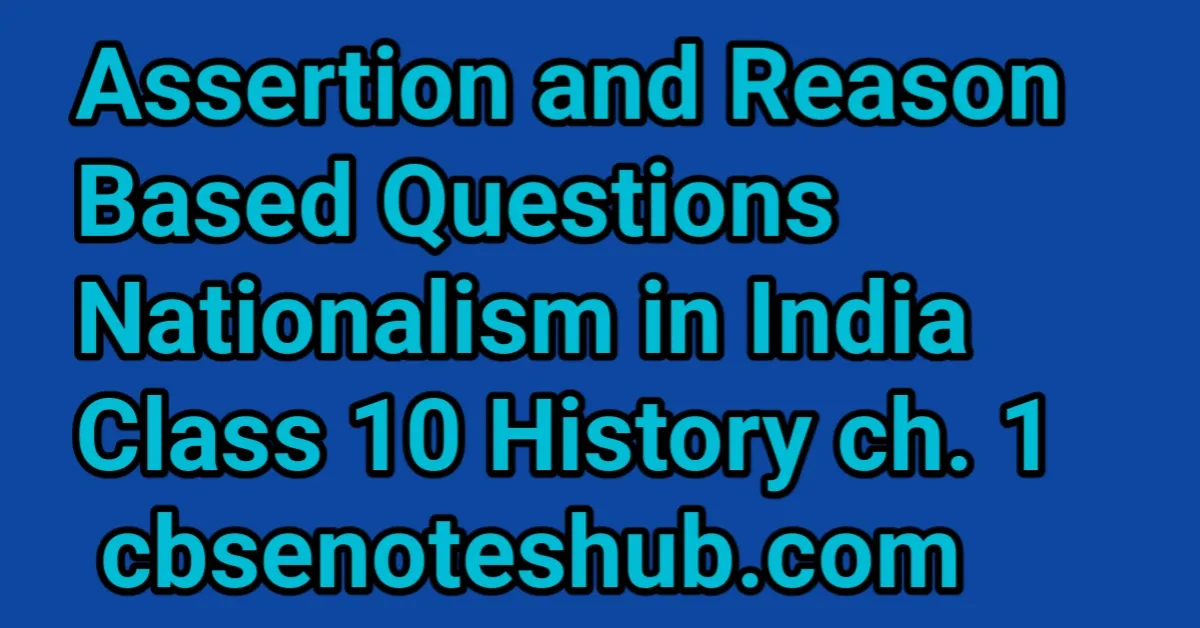Solving assertion and reason-based questions requires an in-depth understanding of the topic. This post provides that understanding for Class 10 History – Chapter: Rise of Nationalism in India.
Assertion and Reason Based Questions – Nationalism in India | Class 10 History-Chapter 2
CBSE: March 2026
In the questions given below, there are two statements marked as Assertion (A) and Reason (R). Read the statements carefully and choose the correct option.
Options:
(i) Both A and R are true and R is the correct explanation of the assertion.
(ii) Both A and R are true but R is not the correct explanation of the assertion.
(iii) A is true but R is false.
(iv) A is false but R is true.
Q.1. Assertion (A): Mahatma Gandhi used a novel method of mass agitation known as Satyagraha.
Reason (R): He believed in the dharma of non-violence.
Ans.: (i) Both A and R are true and R is the correct explanation of the assertion.
Q.2. Assertion (A): In February 1922, Mahatma Gandhi decided to withdraw the Non-Cooperation Movement.
Reason (R): The movement was turning violent in many places.
Ans.: (i) Both A and R are true and R is the correct explanation of the assertion.
Q.3. Assertion (A): Civil Disobedience Movement was launched on 6th April 1930.
Reason (R): The industrial working class did not participate in the Civil Disobedience Movement.
Ans.: (ii) Both A and R are true but R is not the correct explanation of the assertion.
Q.4. Assertion (A): Mahatma Gandhi organised Dalits into the Depressed Classes Association in 1930.
Reason (R): Dr. B.R. Ambedkar demanded separate electorates for Dalits.
Ans.: (iv) A is false but R is true.
Q.5. Assertion (A): The Non-Cooperation Movement gradually slowed down for a variety of reasons in the cities.
Reason (R): As the boycott spread and people began discarding imported clothes, Indian textile mills and handlooms saw a rise in production.
Ans.: (ii) Both A and R are true but R is not the correct explanation of the assertion.
Q.6. Assertion (A): In 1917, Gandhiji organised a Satyagraha to support the peasants of the Kheda district of Gujarat.
Reason (R): The peasants were affected by crop failure and plague epidemic and could not pay revenue, so they demanded relaxation.
Ans.: (i) Both A and R are true and R is the correct explanation of the assertion.
Q.7. Assertion (A): In Awadh the peasants were led by Alluri Sitaram Raju.
Reason (R): The movement here was against talukdars and landlords.
Ans.: (iv) A is false but R is true.
📌 Unification of Germany, Italy, and Britain – Class 10 Notes
Q.8. Assertion (A): Mahatma Gandhi decided to launch Civil Disobedience Movement by violating the Salt Law.
Reason (R): Salt is an essential item consumed by people of all classes.
Ans.: (i) Both A and R are true and R is the correct explanation of the assertion.
Q.9. Assertion (A): After the failure of the Second Round Table Conference, business groups were no longer uniformly enthusiastic.
Reason (R): They feared militant activities, prolonged disruption of business, and the growing influence of socialism among Congress members.
Ans.: (i) Both A and R are true and R is the correct explanation of the assertion.
Q.10. Assertion (A): Gandhiji entered into the Gandhi-Irwin Pact on 5 March 1931.
Reason (R): Ghaffar Khan and Jawaharlal Nehru were jailed, Congress was declared illegal, and meetings were banned.
Ans.: (ii) Both A and R are true but R is not the correct explanation of the assertion.
Q.11. Assertion (A): When Simon Commission arrived in India, it was greeted with the slogan ‘Go back Simon’.
Reason (R): This happened because Mahatma Gandhi was on the Dandi March during that time.
Ans.: (iii) A is true but R is false.
Q.12. Assertion (A): Bankim Chandra Chattopadhyay wrote ‘Vande Mataram’ as a hymn to the motherland.
Reason (R): It was later included in his novel Anandamath and widely sung during the Swadeshi movement.
Ans.: (i) Both A and R are true and R is the correct explanation of the assertion.
Q.13. Assertion (A): Prices decreased between 1913–1918 leading to extreme hardship for the common man.
Reason (R): There was an increase in war expenditure financed by loans and higher taxes; income tax was introduced and customs duties were raised.
Ans.: (iv) A is false but R is true.
Source: NCERT
📌 Romantic Imagination and National Feeling – Class 10 History Part 4
📌 How is Federalism Practised in India – Class 10 Notes

